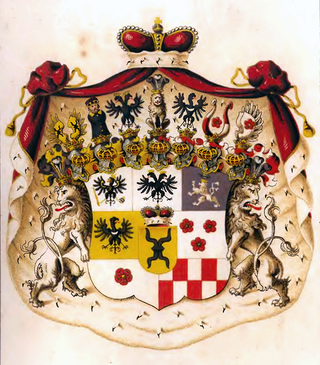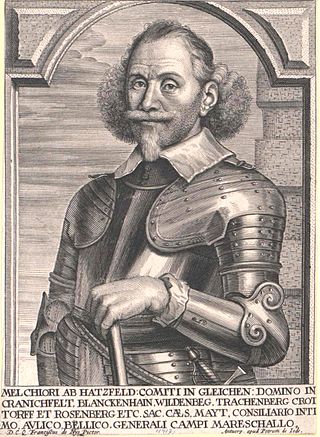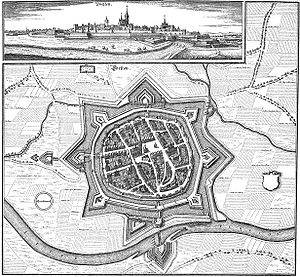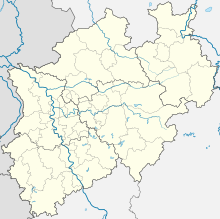
The Second Battle of Breitenfeld, also known as the First Battle of Leipzig, took place during the Thirty Years' War on 2 November 1642 at Breitenfeld, north-east of Leipzig in Germany. A Swedish Army commanded by Lennart Torstensson decisively defeated an Imperial Army under Archduke Leopold Wilhelm of Austria and his deputy Ottavio Piccolomini.

Żmigród is a town in Trzebnica County, Lower Silesian Voivodeship, in south-western Poland. It is the seat of the administrative district (gmina) called Gmina Żmigród.

Ludwig von Siegen was a German soldier and amateur engraver, who invented the printmaking technique of mezzotint, a printing-process reliant on mechanical pressure used to print more complex engravings than previously possible. He was a well-educated aristocrat, and a Lieutenant-Colonel who commanded the personal guard of William VI, Landgrave of Hesse-Kassel, and acted as a personal aide to the ruler, with the title kammerjunker or Chamberlain.

Dorsten is a town in the district of Recklinghausen in North Rhine-Westphalia, Germany and has a population of about 75,000.
The Battle of Vlotho was fought on 17 October 1638. It was a victory for the Imperial Army under the command of Field Marshal Melchior von Hatzfeldt, and ended the attempt by Charles I Louis, Elector Palatine, to recapture the Electoral Palatinate.

The House of Hatzfeld, also spelled House of Hatzfeldt, is the name of an ancient and influential German noble family, whose members played important roles in the history of the Holy Roman Empire, Prussia and Austria.

Amalie Elisabeth of Hanau-Münzenberg was Landgravine consort and Regent of Hesse-Kassel. She married the future William V, Landgrave of Hesse-Kassel in 1619 and became Landgravine upon his ascension to power in 1627. In 1637, military defeats forced her and William V into exile in East Frisia. Later that year, she became regent for their son William VI upon her husband's death. Through skillful diplomacy and military successes in the Thirty Years' War, she advanced the fortunes of Hesse-Kassel and influenced the Peace of Westphalia that brought the conflict to an end. She handed over an enlarged landgraviate to her son when she abdicated upon his majority in 1650. However, her health had deteriorated over the course of the war, and she died soon after her abdication in 1651.

Franz von Hatzfeld was the Prince-Bishop of Würzburg from 1631 to 1642 and the Prince-Bishop of Bamberg from 1633 to 1642.

Gottfried, Count Huyn, Baron of Geleen or Godefridus Comes ab Huyn Baro de Geleen, rose to the rank of Field Marshal in the service of the Holy Roman Emperor during the 30 Years War.
The Hessian War, in its wider sense sometimes also called the Hessian Wars (Hessenkriege), was a drawn out conflict that took place between 1567 and 1648, sometimes pursued through diplomatic means, sometimes by military force, between branches of the princely House of Hesse, particularly between the Landgraviate of Hesse-Cassel and the Landgraviate of Hesse-Darmstadt. It was triggered by a division of inheritance following the death of the last landgrave of all Hesse, Philip I in 1567.

The Battle of Wevelinghoven or Battle of Grevenbroich was one of the final battles of the Thirty Years' War. It took place on 14 June 1648 between troops of Holy Roman Empire and of the victorious Hesse-Cassel. Several sources cite the Julian date of 4 June.

Carl von Rabenhaupt was a Bohemian Hussite nobleman who fought in Dutch and Hessian service during the Thirty Years War and came out of retirement to help the Dutch defend Groningen during the Franco-Dutch War. He made a name for himself as a siege specialist, taking or successfully defending many fortified cities along the Dutch-German border.

The Cologne Diocesan Feud, also called the Neuss War or Burgundian War, was a conflict, which began in 1473, between the Archbishop of Cologne, Ruprecht of the Palatinate and the Landstände of his archbishopric. As a result of the involvement of Charles the Bold of Burgundy and, eventually, the Holy Roman Empire the matter at times assumed a European dimension. It finally ended when Ruprecht died in 1480.

Melchior Graf von Gleichen und Hatzfeldt was an Imperial Field Marshal. He fought in the Thirty Years' War first under Albrecht von Wallenstein and Matthias Gallas, then received an independent command in Westphalia. Usually successful with a smaller corps on this secondary front and victorious at Vlotho and Dorsten, he lost at Wittstock and Jankau in his brief intermezzos as commander of major armies.

The Battle of Wolfenbüttel took place near the town of Wolfenbüttel, in what is now Lower Saxony, during the Thirty Years' War. Swedish forces led by Carl Gustaf Wrangel and Hans Christoff von Königsmarck and Bernardines led by Jean-Baptiste Budes, Comte de Guébriant withstood an assault by Imperial forces led by Archduke Leopold Wilhelm of Austria, forcing the Imperials to retreat.

Johann von Geyso was a German nobleman and General-Lieutenant, who fought during the course of the Thirty Years' War. After studying in a Dutch military academy, Geyso fought as a mercenary in the armies of Sweden, Bohemia, Denmark and the German Protestant Union. In 1628, having gained significant experience in warfare he returned to his native Hesse-Kassel which he served until the end of the Thirty Years' War, reaching the rank of commander in chief of the Langraviate's forces and becoming ennobled.
Ambrosius Franz Friedrich Christian Adalbert von Virmont was a German nobleman and Imperial Count of Virmont and Bretzenheim.

The Battle of Kempen was a battle during the Thirty Years' War in Kempen, Westphalia on 17 January 1642. It resulted in the victory of a French-Weimar-Hessian army under the French Comte de Guébriant and the Hessian Generalleutnant Kaspar Graf von Eberstein against the Imperial Army under General Guillaume de Lamboy, who was captured.

Guillaume III de Lamboy de Dessener, 1590 to 1659, was a Field Marshal in the Imperial Army, who served in the 1618 to 1648 Thirty Years War, and the 1635 to 1659 Franco-Spanish War.

Johann Wilhelm von Hunolstein, also known as Hunoltstein or Hunoldstein, was a professional soldier in Lorrain, Bavarian and Imperial military service during the Thirty Years' War. Since 1643, he was part of the General Staff of the Imperial supreme commanders Gallas and Melander, and commanded himself the entire infantry of either the Imperial or the Bavarian field army.




















